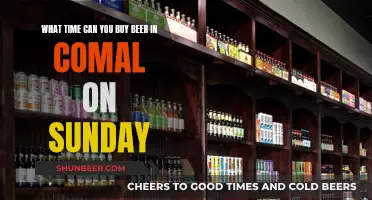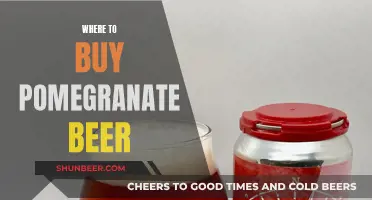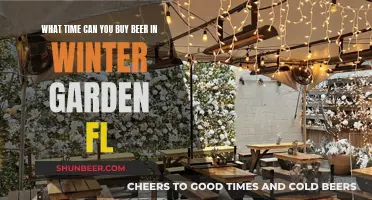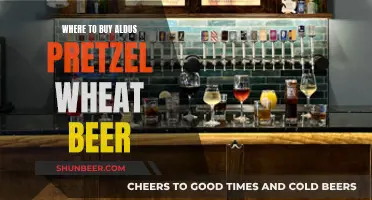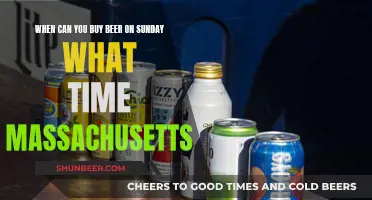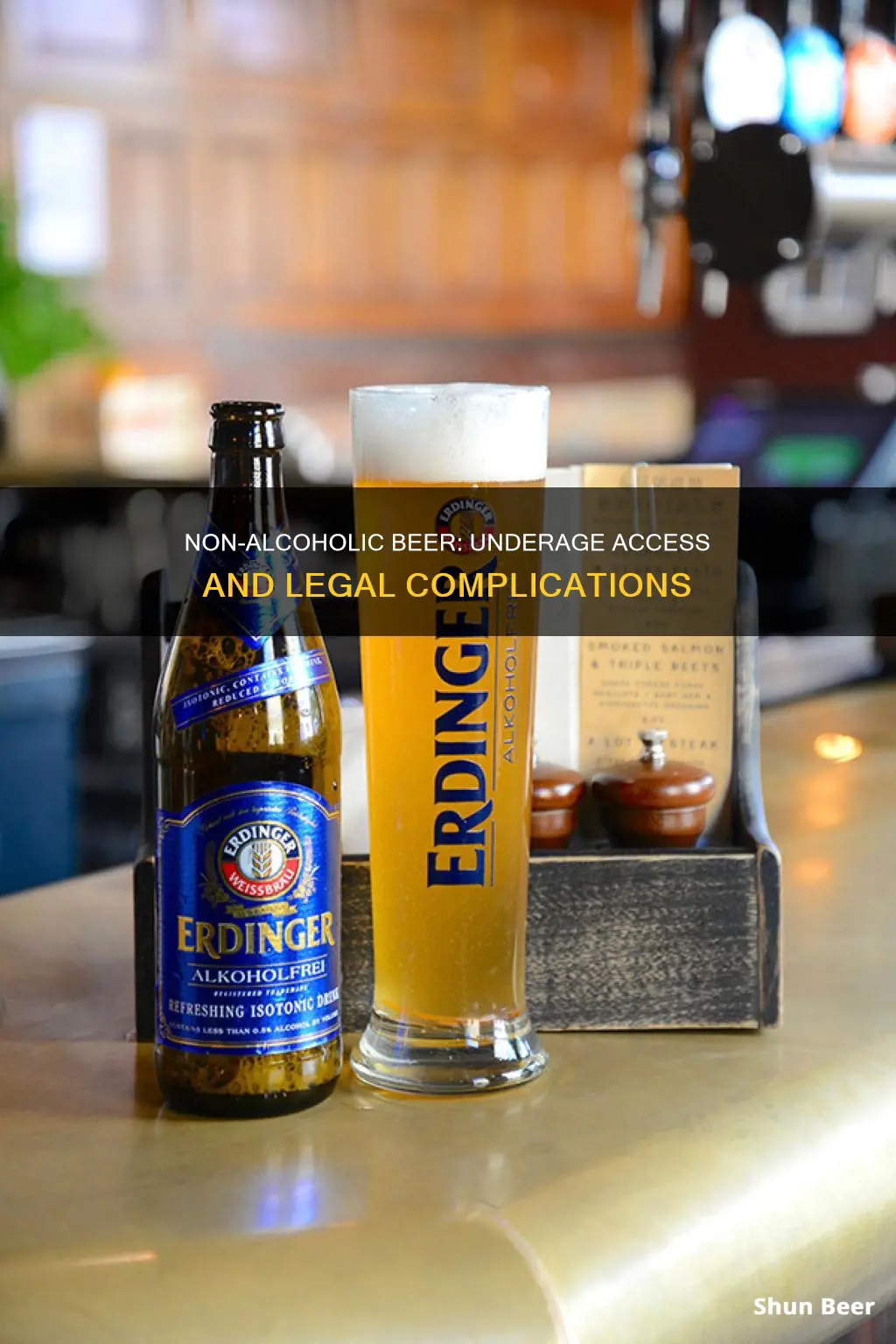
Alcohol can be harmful to children and young people, so there are strict laws in place to restrict buying and consuming alcohol for under-18s. However, these laws do not apply to non-alcoholic drinks, which are legally defined as drinks with less than 0.5% ABV. This means that it is not illegal for minors to purchase non-alcoholic beer, and they can even drink it in licensed premises. Nevertheless, many pubs, bars, and shops treat non-alcoholic drinks the same as alcoholic ones and will not sell them to minors. This is partly to avoid promoting alcohol to children and also to make it easier to enforce rules regarding alcoholic drinks.
What You'll Learn

Under-18s can legally buy non-alcoholic beer in the UK
In the UK, under-18s can legally buy non-alcoholic beer. However, this depends on the alcohol by volume (ABV) of the drink in question. The Licensing Act 2003 states that alcohol means beer, wine, cider, spirits and other liquors over 0.5% ABV. Therefore, any drink below 0.5% ABV is not classed as alcohol, and relevant 'underage laws' do not apply.
Despite this, many retailers and pubs still refuse to serve non-alcoholic beer to under-18s. This is due to the practical difficulties of distinguishing non-alcoholic beer from alcoholic beer, both in terms of packaging and once the product has been served. Additionally, retailers may wish to avoid promoting alcohol to children, even in the form of alcohol-free substitutes, and to make it easier to enforce rules regarding alcoholic drinks.
Some retailers have responded to queries about their policies on selling non-alcoholic beer to under-18s by stating that they do not want to give the impression that they are permitting the sale of products that contain alcohol to under-18s. Others have said that they do not want to promote alcohol-like products to underage customers.
While it is not illegal for under-18s to buy non-alcoholic beer in the UK, it is still uncommon for retailers and pubs to make these sales due to the practical and ethical considerations outlined above.
Buying Beer in Kansas: Sunday Shopping Laws Explained
You may want to see also

Shops and pubs can refuse to sell non-alcoholic beer to under-18s
In the UK, it is illegal for under-18s to buy alcohol. However, this does not include drinks that are below 0.5% ABV, as these are not considered alcoholic under the Licensing Act 2003. This means that non-alcoholic beer, which typically contains between trace amounts to 0.5% ABV, can be sold to minors.
Despite this, shops and pubs can refuse to sell non-alcoholic beer to under-18s. This is often due to the difficulty in distinguishing non-alcoholic beer from regular beer, which could lead to accidental sales of alcoholic drinks to minors. Additionally, retailers may wish to avoid promoting alcohol to minors, even indirectly, and to make it easier to enforce rules regarding alcoholic drinks.
Some retailers have stated that they will not sell non-alcoholic beer to under-18s due to the risk of accidentally selling alcoholic drinks. For example, a spokesperson for JD Wetherspoon said:
> "We do not allow non-alcoholic beer/lager to be served to under-18s despite it being legal to do so. The reason for this is that it is operationally very difficult, once the product has been served, for staff supervising the floor to distinguish it in the glass from an alcoholic product that under-18s are not permitted to consume."
Similarly, Tesco and Waitrose have stated that they do not want to promote alcohol-like products to underage customers. A spokesperson for Co-op said:
> "As a responsible retailer, we voluntarily restrict the sale of non-alcoholic drink products that resemble a beer, wine, or spirit, as we do not want to give the impression to customers that people under 18 are being permitted to purchase products that contain alcohol."
Retailers may also wish to avoid confusing their staff by requiring them to constantly check the ABV of drinks they are selling to people suspected of being under 25.
Buying Beer in Lawton, Oklahoma: What's the Law?
You may want to see also

Non-alcoholic beer often treated the same as alcoholic beer
In many places, non-alcoholic beer is often treated the same as alcoholic beer. This means that it is not sold to those who cannot prove they are over the legal drinking age, and it is also not sold outside of licensing or alcohol sale hours. This is despite the fact that, in most regions, drinks under 0.5% ABV are not legally considered alcohol and are not subject to the same restrictions as alcoholic drinks.
There are two main reasons for this. Firstly, retailers want to avoid promoting alcohol to children. Although non-alcoholic beer may not contain much alcohol, or any at all, the packaging and the drink itself are almost indistinguishable from alcoholic beer. This means that promoting "alcohol substitute" drinks to minors could indirectly promote similar products that do contain alcohol. Secondly, treating non-alcoholic drinks the same as alcoholic drinks makes it easier to enforce rules regarding alcoholic drinks. This is especially true in pubs and bars, where owners are responsible for what people drink on the premises, as well as what they buy. In these settings, it makes sense for staff to treat non-alcoholic beer the same as alcoholic beer to more effectively monitor what customers are drinking.
Some retailers have voluntarily restricted the sale of non-alcoholic beer to minors. For example, the corporate arm of Budweiser and Beck's, AB-Inbev, has a Responsible Marketing and Communications Code that covers alcohol-free and non-alcoholic products. The Portman Group, a UK trade group of alcoholic drinks producers, also has a voluntary Code of Practice on the Responsible Naming, Packaging and Promotion of Alcoholic Drinks that covers non-alcoholic products.
In the UK, under-18s can legally purchase low and non-alcoholic beer in pubs, as long as the drinks are below 0.5% ABV. However, many pubs will not permit these sales. For example, JD Wetherspoon does not allow non-alcoholic beer/lager to be served to under-18s, as it is difficult for staff to distinguish between customers who are drinking alcohol and those who are not.
Texas Beer Laws: When Can You Buy?
You may want to see also

Non-alcoholic beer packaging is similar to alcoholic beer
In many countries, non-alcoholic beer is legally available to people under the age of 18. However, the specific regulations regarding the sale of non-alcoholic beer to minors vary across different regions. In the UK, for instance, the Licensing Act of 2003 defines "alcohol" as beverages containing more than 0.5% ABV (alcohol by volume), which means that non-alcoholic beer falls outside the scope of this legislation. As a result, under-18s can legally purchase these drinks in pubs and other establishments. Nevertheless, the final decision lies with the pubs and retailers, who often choose not to sell non-alcoholic beer to minors due to the challenges of distinguishing it from its alcoholic counterpart once served.
The packaging of non-alcoholic beer plays a crucial role in its marketing and perception by consumers. Interestingly, the packaging of non-alcoholic beer often resembles that of its alcoholic equivalent. This similarity in packaging design is intentional and serves a strategic purpose. Beer brands employ specific brand codes, such as colours, shapes, words, and iconography, to create a distinct identity for their products. By mimicking the packaging of regular beer, non-alcoholic beer brands aim to convey a sense of familiarity and similarity to consumers. This strategy suggests that their product is just as enjoyable and satisfying as the traditional alcoholic option.
The visual resemblance between the two types of beer extends beyond the overall design. Non-alcoholic beer often mimics the specific elements found on the packaging of its alcoholic counterpart. This includes the use of similar colours, fonts, and even brand names that evoke those of established alcoholic beer brands. For example, a non-alcoholic lager might use a predominantly white can with black accents, mimicking the colour scheme of popular alcoholic lager brands. Similarly, the brand name might have a similar syllable structure or incorporate geometric shapes reminiscent of well-known alcoholic beer logos.
The intention behind this packaging strategy is twofold. Firstly, it helps non-alcoholic beer brands to quickly communicate to consumers that their product is comparable to regular beer in terms of taste, quality, and overall drinking experience. By leveraging the established brand codes of popular alcoholic beers, non-alcoholic brands can signal to consumers that their product is a viable alternative. Secondly, from a practical standpoint, this packaging design makes it easier for retailers to stock and display non-alcoholic beer alongside its alcoholic counterparts. It allows for a seamless integration of non-alcoholic options into existing beer displays, making it more convenient for consumers to find and purchase these products.
While the packaging similarities between non-alcoholic and alcoholic beer serve a strategic purpose, they can also lead to confusion among consumers, particularly when it comes to distinguishing between the two products. This is especially true for non-alcoholic beers that closely mimic the iconic packaging of well-known alcoholic beer brands. In some cases, consumers may struggle to differentiate between the two, which can lead to accidental purchases or misunderstandings about the product's characteristics.
Illinois Sunday Beer Buying: What's Allowed?
You may want to see also

Non-alcoholic beer can be a danger to minors
Non-alcoholic beer can pose a danger to minors, and there are several reasons why this is a cause for concern. Firstly, non-alcoholic beverages can contain trace amounts of alcohol, typically up to 0.5% ABV, which is still enough to expose minors to the substance. While this amount is not considered high enough to cause intoxication, even in large quantities, it does introduce alcohol to minors, which may lead to potential issues with substance abuse later in life.
Secondly, non-alcoholic beer is often packaged and branded very similarly to its alcoholic counterpart, making it difficult to distinguish between the two. This similarity in appearance can lead to accidental consumption of alcoholic beverages by minors, which is a significant health risk and can have detrimental effects on their well-being and brain development.
Additionally, the availability of non-alcoholic beer to minors may act as a gateway to alcoholic beverages. Minors who are curious or seeking to fit in with their peers may be more inclined to experiment with alcoholic drinks if they have already been exposed to non-alcoholic versions. This could lead to underage drinking and the associated risks, including health hazards, impaired judgment, and the potential for developing a dependency or addiction.
Furthermore, the consumption of non-alcoholic beer by minors can also be a concern due to the potential presence of other harmful substances. While these beverages are marketed as "non-alcoholic," they may still contain ingredients that are not suitable for minors. For example, they often contain high levels of sugar and other additives that can contribute to health issues such as obesity, tooth decay, and behavioural problems.
Lastly, the consumption of non-alcoholic beer by minors can also impact their perception of alcohol consumption as a whole. Minors who are allowed to consume these beverages may develop a distorted view of alcohol's role in society, believing it to be a necessary or expected part of social interactions. This can lead to a higher risk of developing unhealthy relationships with alcohol later in life, as they may view it as a normal and harmless part of adulthood.
In conclusion, while non-alcoholic beer may seem like a harmless alternative for minors, it can pose several dangers to this vulnerable demographic. It is essential to consider the potential risks and take a cautious approach to protect minors from the adverse effects of alcohol and its associated cultural implications.
Black Friday Beer: Should You Buy?
You may want to see also
Frequently asked questions
In most regions, including the UK and many US states, drinks under 0.5% ABV aren't legally considered alcohol and aren't subject to the same restrictions as alcoholic drinks. However, many shops and pubs still treat non-alcoholic drinks the same as alcoholic drinks. This is to avoid promoting alcohol to children and to make it easier to enforce rules regarding alcoholic drinks.
The packaging of non-alcoholic beer is almost identical to that of regular beer, which makes it difficult for staff to distinguish between the two. This is especially true in pubs and bars where owners are responsible for what people drink on the premises.
While non-alcoholic drinks are not subject to the same restrictions as alcoholic drinks, they are often produced by companies that also produce alcoholic drinks. Allowing minors to buy non-alcoholic drinks could indirectly promote alcoholic drinks to them.


